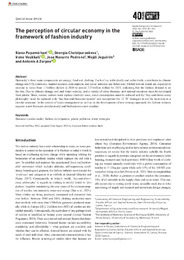Título :
The perception of circular economy in the framework of fashion industry |
Autor :
Papamichael, Iliana
Chatziparaskeva, Georgia
Voukkali, Irene
Navarro Pedreno, Jose
Jeguirim, Mejdi
Zorpas, Antonis A |
Editor :
SAGE Publications |
Departamento:
Departamentos de la UMH::Agroquímica y Medio Ambiente |
Fecha de publicación:
2023-01-23 |
URI :
https://hdl.handle.net/11000/37890 |
Resumen :
Humanity’s three main components are energy, food and clothing. Each of us, individually and collectively, contributes to climate
change and CO2 emissions, natural resource consumption, and social attitudes and behaviour. Global fashion trends are expected to
increase in value from 1.5 trillion dollars in 2020 to around 2.25 trillion dollars by 2025, indicating that the fashion demand is on
the rise. Due to climate change, soil and water scarcity, and a variety of other diseases, new natural resources must be developed
from plastic fibres, natural colours must replace synthetic ones, water consumption must be reduced and the ‘buy-and-throw-away
philosophy’ must be replaced with ‘buy-less-and-these-are-needed’ and incorporate the 12 ‘R’ strategies to aid the transition to a
circular economy. In the context of waste management as well as on the development of new strategy approach, the fashion industry
requires a new business circular model and furthermore a new mindset.
|
Palabras clave/Materias:
Business circular model
Fashion development
plastic pollution
waste strategies |
Área de conocimiento :
CDU: Ciencias puras y naturales |
Tipo de documento :
info:eu-repo/semantics/article |
Derechos de acceso:
info:eu-repo/semantics/openAccess
Attribution-NonCommercial-NoDerivatives 4.0 Internacional |
DOI :
https://doi.org/10.1177/0734242X221126435 |
Publicado en:
Waste Management & Research, 41(2), 251-263, 2023 |
Aparece en las colecciones:
Artículos Agroquímica y Medio Ambiente
|
 La licencia se describe como: Atribución-NonComercial-NoDerivada 4.0 Internacional.
La licencia se describe como: Atribución-NonComercial-NoDerivada 4.0 Internacional.
.png)
